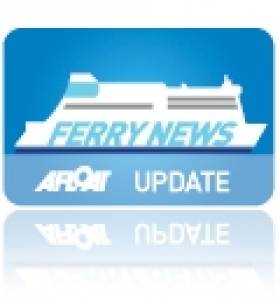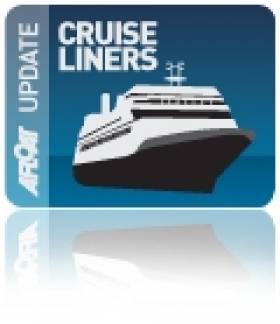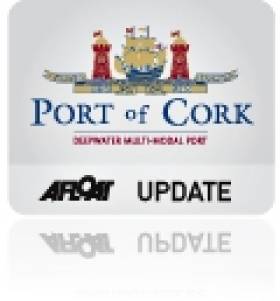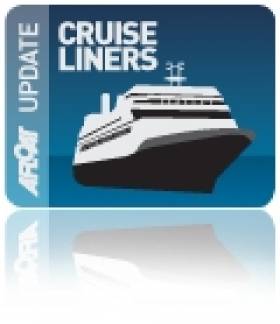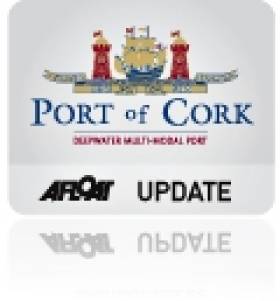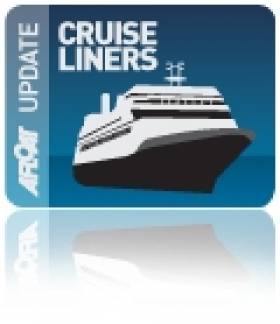Displaying items by tag: port of Cork
LD Lines Launch New UK-Spain Route
#NewROUTE – LD Lines has begun a new UK-Spain route between Poole, Dorset and Santander in Cantabria served by ro-pax Norman Asturias with a capacity for up to 500 passengers, 200 cars or 110 freight vehicles, writes Jehan Ashmore.
As of mid-afternoon today, the 27,414 tonnes ferry entered the western approaches of the English Channel having departed Spain yesterday at 18.00hrs and is due to dock in the Dorset port this evening at 19.00hrs.
Norman Asturias was deployed to the new twice weekly return operated route having been displaced from the St. Nazaire (Montoir-de-Bretagne)-Gijón route which is now operated by Scintu, a sister of the popular Visentini Italian built ro-pax design ferries. The French-Spain route is part of the EU's 'Motorways of the Sea (MOS) programme to divert traffic away from congested roads and transferring onto faster vessels (i.e. the ro-pax design).
The new 26-hour route represents a major development to LD Lines creation of an Atlantic ferry network, providing new links to serve the UK, French, Spanish and Portuguese freight. In addition catering for UK tourism markets and making regions such as the Algarve within easier reach.
To cover the long distance route, the 24-knot Norman Astuarias was deployed to the route. Among her sisters are Celtic Horizon and her predecessor on Celtic Link Ferries Rosslare-Cherbourg route the Norman Voyager. In mid-October she carried out berthing trials in Poole on behalf of her fleetmate.
LD Lines which is part of the Louis Dreyfus Group had tipped their toes into the Irish ferry market several years ago on the short-lived Rosslare-Le Havre operation. The service was only run at weekends as Norman Voyager also and remains running weekday sailings between the French port to Portsmouth.
The revival of the Rosslare route to Normandy had not been operated for many years when Irish Continental Group's (ICG) ferry division Irish Ferries ran the route served by St. Killian II until 1997. Following LD Lines departure from the Irish route, Celtic Link quickly seized a charter option of the 2008 built ferry until current route vessel Celtic Horizon came on the scene two years ago.
The introduction of LD Lines onto the Biscay run brings competition to long established operators Brittany Ferries whose services also run between Santander and the UK (Plymouth and Portsmouth). As previously reported on Afloat.ie, Brittany Ferries took over the Portsmouth-Bilbao route following P&O's exit of the Iberian service served by the former ICG owned Pride of Bilbao.
On another Irish related note the new LD Lines route will sharpen and focus minds again on previous calls to have a similar ro-pax operated service linking Ireland to Iberia.
As also reported, the Port of Cork has been actively involved in attempts to introduce such a service through the PROPPOSE partnership between the Irish port and Gijon.
Currently goods totalling 110,000 tonnes move between Ireland and Iberia by road via the UK and France with the consequent cost, environmental impact and susceptibility to French toll-roads. In addition that country's banning of HGV traffic at weekends and the planned implementation of Ecotax for trucks from 1 January 2014.
Port of Cork Welcomes MV Albatros, Final Cruise Call of 2013
#portofcork – The Port of Cork welcomed MV Albatros, the final cruise liner of the 2013 season to Cobh today following what the Port of Cork confirmed as the 'busiest cruise season on record for Cork'.
In total, 62 cruise liners called to the Port of Cork, home to Ireland's only dedicated cruise berth, carrying a record 123,000 passengers and crew. These guaranteed visitors are a welcome treat for Cork, bringing a much needed boost to the local economy for eight months of the year. In 2013 eight liners made their maiden calls to the Port of Cork, highlighting the continuing growth of this business and the commitment from cruise companies to introduce new ships to the region.
While some of these cruise calls stay overnight, many stay for a full day allowing their passengers ample time to enjoy the many exciting shore excursions on offer or simply time to experience Cork City and region independently. According to Irish Rail, statistics for the cruise season showed up to 28% of cruise passengers took the train from Cobh to Cork City. For all of the larger liners, Irish Rail offers extra trains to ensure passengers can get to Cork City without delay. This works well for passengers, with many deciding to take the train from Cobh to Cork in the morning and spend the afternoon in Cobh or take one of the ship's shore excursions in the afternoon.
It is imperative that passengers are offered a choice of shore excursions, both full and half day, so they tailor what is offered to suit them. The more choice there is for passengers the better, as this works in favour particularly for repeat passengers. It is well noted within the cruise industry that it is incumbent on all ports, destinations and shore tour operators to reinvent themselves occasionally, to attract both new and repeat passengers. The same must be done for Cork and the Port of Cork continues to work with City and County Councils, Irish Rail, Tour Operators and attractions to ensure Cork continues to meet the demand of cruise lines and their passengers.
Speaking about the busiest cruise season on record for Cork, Mr John Mullins Chairman of the Port of Cork said: "This has been an excellent year for Cork and we have seen a huge jump in passenger numbers this year. This increase is down to the dedicated cruise berth and the number of calls of large cruise ships. For example Princess Cruise's ship, MV Caribbean Princess called seven times this year, each time bringing over 4,000 passengers and crew to Cork. The fact that people can just walk on and off the ship to go shopping or touring increases the economic impact to the region. The passengers are offered the option of taking a tour and then come back on the ship to change before going out again on their own to do some shopping, eating or drinking and avoiding the repeated hassle of tendering or shuttle buses."
With these ambitious plans however, the Port of Cork cannot achieve them alone.
Mr Mullins continued: "There are also a great amount of activities and attractions on offer in Cork and the region for cruise passengers, and we remain fully committed to increasing our calls from 62 this year to 80 in the next five years. To do this, we need the continued support of Irish Rail to offer more trains with added incentives, the tour operators need to design and offer new shore excursions at competitive prices and we need the continued support from both City and County councils to encourage the promotion of the region, so that everything Cork has to offer is utilised to its full potential."
Over the years, the Port of Cork has invested in the cruise business and this is something the Port is committed to continuing. As cruise ships get larger, cruise companies are searching the globe for suitable ports capable of handling such vessels. Cork has a huge advantage over other Irish ports in that it is a naturally deep-water port with no restrictions; however, Cork needs to enhance the facilities in Cobh to be able to handle even larger liners and to have the option of accommodating two liners at one time.
Following this excellent cruise season, the Port of Cork would like to express their thanks to all their Cork Cruise members, Irish Rail, TEAM, tour operators, bus companies, travel agents and the many different attractions around the region for their continued support and cooperation with the cruise business. The Chairman thanked the board of directors at the port, management team and staff for realising the potential of this business for both the Port and the local economy, and their commitment to provide future infrastructure to support the business.
Port of Cork Records Sea Bed Ploughing with Ground Breaking 'Succorfish' Technology
#portofcork – A project that has allowed the Port of Cork to precisely monitor and record the winter program of seabed ploughing in real time for the first ever time is being delivered by Succorfish in partnership with Irish marine communication specialists SEA-Tech.
The groundbreaking exercise, which is being carried out aboard a utility vessel working to lift sediment from the port seabed into the water column and back out to sea, sees live, up-to-the-minute and highly valuable location data transferred back to officials instantly in real time. And, given its success, it is anticipated that it could change the way future ploughing operations are carried out as well as greatly improve efficiency for the world's second largest natural harbour.
Succorfish, a leading provider of intelligent M2M data transfer technology, next generation telematic communication systems and GSM/GPRS asset tracking products, has installed its SC2 vessel monitoring unit and RFID winch sensors aboard MV Denis Murphy, a 20m multi-cat utility vessel used for maintenance duties including bed leveling and oil pollution response.
Over the next six months, Port of Cork and SEA-Tech personnel will have the ability to accurately record vessel movement more frequently and in real time, and analyse activity as it happens from specfic harbour areas using the system's innovative 'geofence' facility.
Succorfish Head of Marine, Tom Rossiter, explained, "This project builds on the success working with Welsh scallop fishermen in Cardigan Bay and by partnering with SEA-tech in Ireland, we can demonstrate how the SC2 is becoming an integral piece of equipment for vessel operators whether they be skippers, fleet managers or marine authorities.
"The Port of Cork project is significant as the technology used has the potential to change operational methods and increase efficiency here and at similar ports worldwide. Never before has activities such as ploughing been accurately mapped onshore at the same time as the activity is being carried out on the vessel and this will be beneficial for future planning as well as day to day operations of the port.
Our technology provides the most up to date information from remote areas of the business in an accessible and cost effective manner."
The SC2 monitoring unit uses state of the art GPRS/GSM technology, Iridium satellite reporting as well as bespoke online software to offer the marine industry a complete low cost solution. It includes sector specific features including e-log data reporting, SOS emergency alarm, anti hijack alert, radio frequency identification (RFID), crew safety systems and also deep sea thermal sensor attachments for fishing gears.
The system installed aboard the MV Denis Murphy also offers 100% data security and allows users to access their own information via a password protected online interface.
Critically, and as well as Iridium satellite reporting, this information is available via mobile devices allowing users to monitor progress whilst on the move. The RFID scanner fitted to the heavy duty winches also demonstrates the SC2's ability to monitor activity remotely across all areas of the vessel's operations.
Another proven feature is the geofence facility that manages access to certain areas and alerts the operator by email or text whenever a vessel enters or exits such waters. It is currently used successfully by fishery managers in the UK to monitor marine protected areas to two metres accuracy and gives operators an exceptional level of confidence in knowing the exact location of their vessel at any given time.
Arnaud Disant, Owner of SEA-Tech added, "Information gained from this exercise will be of significant value to both ourselves as specialist marine consultants as well as the Port of Cork as end users. From evidence obtained so far the opportunities that it presents are very encouraging and could have a long lasting effect on how port operators carry out commercial and operational activities both in Ireland and worldwide."
Port of Cork Signs Up to Atlantic Alliance Cruise Ship Destination Project
#atlanticalliance – The ATLANTIC ALLIANCE is a marketing project of 18 ports along Europe's West coast between Hamburg and Lisbon, including Britain and now an Irish port. The project highlights to cruise companies that there is in Europe an attractive alternative to the Mediterranean and Baltic. The multifaceted character and diversity of the Atlantic Alliance members offer a versatile portfolio of cruise content for the cruise companies.
Hamburg, 23rd of September 2013. The Atlantic Alliance is delighted to welcome the Port of Cork to the association. With the addition of Cork, the first Irish port to join the Alliance, the marketing project now covers in total eight countries. "The Alliance is proud to extend the region by aiming towards establishing a Euro-Atlantic destination on its own", says Nadine Palatz, Manager Atlantic Alliance.
Cork represents a key strategic member in terms of the implementation of the new EU sulphur directive which is due to come into effect in 2015. Within a North Sea context, this gives Cork an advantage for future cruise calls.
Port of Cork is on the South Coast of Ireland and makes the Euro-Atlantic picture more complete, as marketed by the Atlantic Alliance.
"Cork is home to some of Ireland's most famous tourist attractions such as Blarney Castle and Jameson Whiskey Distillery and also serves as a convenient gateway for visiting the many picturesque towns and sights of West Cork, Waterford and Killarney. We are delighted to be joining Atlantic Alliance in promoting Cork as a 'must see' destination on Ireland's south coast" commented Captain Michael McCarthy, Commercial Manager, Port of Cork Company.
The Port of Cork is home to Ireland's only dedicated cruise berth in Cobh and will have welcomed a total of 61 cruise vessels carrying over 100,000 passengers and crew by the end of the 2013 season. This is up from 35 calls in 2005 and the Port of Cork has ambitions to grow the number of cruise calls to 80 over the next five years and to increase turn-around calls and overnight stays.
All cruise vessels that call to Cork are given a very special welcome courtesy of Cork Cruise, providing tourist representatives who go on board each vessel, a display of traditional Irish dancing for passengers and a fond farewell on the quayside with a performance by a local brass band. These efforts do not go unnoticed by the passengers and the cruise lines and in 2011 the Port of Cork was awarded two Cruise Insight Awards for 'Best Shore Side Welcome' and 'Best Tour Guides'.
Cruiseship Callers Near End of Season for Port of Cork
#CorkCruiseCallers – The Port of Cork cruise season is nearly over in a year that in total will welcome 60 cruise ships carrying in excess of 100,000 passengers and crew to the region, writes Jehan Ashmore.
Today two cruiseships are visiting Cork Harbour. They are Royal Caribbean Internationals Vision of the Seas (78,340grt) berthed at Cobh and upriver is Seabourn Cruise Line's luxury mega-yacht Seabourn Pride.
Seabourn Pride of nearly 10,000 gross tonnes and with just a 204 passenger capacity is berthed on the Lee at Custom House Quay (North), where yesterday the Naval Service OPV L.E. Emer (P21) was decommissioned.
Over the last 10 years, the Port of Cork has invested €8 million in upgrading and improving cruise facilities and this has made a major impact on the number of calls, increasing from 35 in 2005 to 60 for this year.
The Port of Cork has high aims to grow the number of cruise calls to 80 over the next five years and to increase turn-around calls and overnight stays.
Earlier this year, the Port of Cork announced details of their sister seaport agreement with PortMiami, the "Cruise Capital of the World".
The sister seaport agreement will benefit the Port of Cork and PortMiami in collaborating on the exchange of information and ideas, with the intended aim of increasing both cargo and cruise trade between ports.
The final cruise ship caller is Pheonix Reisen's Albatros (28,518grt) with a call also to Cobh in early October. She was launched as Royal Viking Sea four decades ago in 1973 and is to visit the lower Cork Harbour town for around half a day.
Cork Harbour Open Weekend 2013 Programme Announced
#CorkHarbour – As previously reported the Cork Harbour Open Weekend (14-15 Sept) programme is packed with lots of activities on offer for all ages and activities for all the family, both on and off the water. Why not try out sailing or visit an Irish Naval Ship or cheer on the dragon boats!
The open weekend is a great opportunity for people to see exactly what Cork Harbour has to offer, and this year is no exception with the second largest natural harbour in the world playing host to a number of events.
An Inter-Firm Dragon Boat Race on Lapps Quay Cork City organised by Meitheal Mara will take place on Saturday at 3pm, kayaking in Cobh and Cork City, a raft race organised by Scouting Ireland, a free open day at the National Maritime College of Ireland (NMCI) in Ringaskiddy and the Irish Naval vessel L.E.Orla will be open to the public for free tours on both Saturday and Sunday.
For anyone interested in trying their hand at sailing the world's oldest yacht club, RCYC in Crosshaven will open their doors to provide sailing for adults and children on Saturday at 11am. This is a great way for everyone to experience the wonderful sport of sailing within Cork Harbour.
Cork Boat Club in Blackrock invites the public to come along and tour their boathouse, meet the rowers and enjoy a coffee or some home baking in their café on Saturday at 11am.
To celebrate Cork Harbour Open Weekend, Cork County Council is offering individuals and families an opportunity to visit Spike Island to experience the rich history which this Island has to offer at significantly reduced rates. Children's Entertainment will be provided on both days from 12pm – 5pm with free guided tours of the Island taking place on the hour from 11am – 3pm departing from the Coffee Shop, Spike Island. The Cobh Animation Team dressed in appropriate period costumes will also be present. Visitors also have the opportunity to stroll on the 1.6km Glacis Walk, a walkway developed around the perimeter of the fort with its unique views of the harbour.
The ferry will leave Kennedy Pier, Cobh regularly from 11am – 3pm with return ferries available until 6pm on both days. The cost is €5 per adult and €15 per family (1adult& 3 children or 2 adults & 2 children, each additional child will cost €3).
Camden Fort Meagher will be hosting Military Re-enactments from the Celts, Romans right through to World War 1&2 with over 60 re-enactors on site. There will also be a fancy dress themed weekend with prizes for different categories. Admission details can be found on www.camdenfortmeagher.ie
In Cobh, there will be crab fishing for kids at The Promenade from 3 – 5pm on the Saturday, while on Sunday the Band 1 Southern Brigade will perform on the Victorian bandstand at 3pm.
Also in Cobh on both Saturday and Sunday, there will be a final opportunity to see the magnificent photograph exhibition on Cork Dockyard in Cobh Heritage Centre. Admission is free.
For anyone with an interest in the Lusitania tragedy, local historian Jack Gilmartin will attend the Lusitania graves in the Old Church Cemetery in Cobh and outline the town's links with the tragedy of the sinking of the Lusitania in 1915, on Sunday at 2pm.
Taking place on Saturday, 15th September at 2.30pm will be an air/sea rescue demonstration in the lower harbour carried out by the Irish Coastguard. This is a super spectacle for everyone to watch from the shoreline and see the incredible work carried out by our Coastguard.
Aimed at embracing what Cork Harbour has to offer, the Cork Harbour Open Weekend aims to raise awareness of the different activities available for people in the harbour both on and off the water. It's a great day for all the family with many events are free to everyone.
The idea for a Harbour Open Day, now extended to a full weekend, emerged from discussions between various stakeholders involved in the development and implementation of the Integrated Strategy for the Harbour in 2007. This has been taken forward by the Harbour Management Focus Group (HMFG) which meets quarterly to exchange information on Harbour issues. A HMFG working group comprising representatives from UCC, City and County Councils and the Port of Cork set about working together to engage users of the Harbour and to organise the Open Day.
For more information on Cork Harbour Open Weekend and see the full programme of events visit www.corkharbour.ie or email [email protected]
Luxury 54m Motoryacht Visits Cork City Marina
#Motoryacht - Luxury motoryacht M.Y. Fortunate Sun which has luxurious accommodation for 10 guests and 12 crew docked at the Port of Cork's City Marina yesterday, writes Jehan Ashmore.
As previously reported, the 851 gross tonnes vessel on a call to Dublin Port in 2011 became the largest vessel to transit through the Samuel Beckett swing-bridge. On her visit to Cork, the vessel is moored along the pontoon off South Custom House Quay.
She is registered in the Caymen Islands and the charter vessel has a steel 54m long hull on a beam of 10.60m. The streamlined aluminium superstructure and also interiors are the work of Tim Heywood Design.
The decade old vessel completed by Oceanfast of Australia is powered by 2x 1737kW MTU 12V 4000M70 diesel engines. This delivers a flat-out speed of 17.3 knots and a range of 5,000 nautical miles.
Cork Harbour Open Weekend & Dockyard Photo Exhibition
#CorkHarbour – Cork Harbour Open Weekend (14-15 September) as previously reported will also include a Harbour Photographic Exhibition of close to 200 photographs covering all aspects of the development of Cork Dockyard, the ships built and repaired.
The Cork Dockyard Ships & Shipbuilding photo exhibition sponsored by the Port of Cork Company was launched last week in advance of the Verolme Workers Gathering Weekend and is currently on view at Cobh Heritage Centre until 15 September.
The photographic display also includes photographs of the shipyard workers tracing the strong local history of shipbuilding in Cork Harbour, which was recognised at a ceremony held last weekend at the former Verolme Cork Dockyard, now the site of a ship-repair only business.
Meanwhile, Cork photographer Robert Bateman whose original work features in the exhibition has published a fascinating gallery online to celebrate the Verolme Workers Gahering weekend. View the gallery here.
Cork Harbour Open Weekend Plays Host to Maritime Events
#CorkHarbour – The Cork Harbour Open Weekend takes place on 14-15 September and once again organisers promise it to be an excellent weekend of fun for all the family, with many events held free of charge to the public.
The open weekend is a great opportunity for people to see exactly what Cork Harbour has to offer, and this year will be no exception with the second largest natural harbour in the world playing host too many different activities.
Events will take place in Cobh, Crosshaven, Ringaskiddy, Monkstown, Camden Fort Meagher, Spike Island and Cork City, spanning the entire harbour and showcasing all the best in Maritime heritage.
This year sees the return of the popular hop-on hop-off boat tour, free tours of an Irish Naval vessel will also be open to the public for both days in Cork City.
Organisers, the Port of Cork Company and Cork County Council are particularly excited about the raft race organised by the scouts on the River Lee which no doubt will be a great spectacle from Cork City quays.
While the programme of events is still coming together, organisers confirmed there will be an open day in the RCYC for anyone keen to try out sailing.
There's also a children's crab fishing competition in Cobh, a free open day at the National Maritime College of Ireland (NMCI), a rowing race around Spike Island, an Air Sea Rescue Demonstration and family fun on Spike Island.
Click link to download copy of the programme and the promotional poster.
Follow events on www.corkharbour.ie, Facebook and on Twitter @corkharbour using the hashtag #corkharbour13
Cruiseship Trio Head for Cork Harbour
#CorkCruiseCalls – The Port of Cork will be busy tomorrow as three cruiseships capable of carrying a combined total of 4,200 passengers are to visit the natural harbour, writes Jehan Ashmore.
First to make an entrance will be Celebrity Infinity followed by AIDAcara, a recent caller to Dublin Port and making up the trio, Club Med 2, which too called to the capital port today.
AIDAcara is to berth alongside Cobh Cruise Terminal while the other pair are due to dock at the Ringaskiddy Deep Water Berth.
As previously reported, the cruiseship sector is worth more than €40 million annually to the Cork economy.
August is the busiest month for the Port of Cork cruise season and by the end of this month the port will have welcomed 21 cruiseships alone and carrying up to 30,000 passengers.
By the end of the season, more than 60 cruiseships will have visited.


























